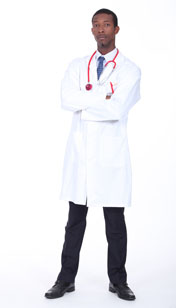Fourth-year medical students have been talking a lot about their perfect match these days: first impressions, the one who called right after they met, some that were too far away. For many, “match week” — this week — is what they’ve been working toward over the past four years. It’s the week that decides if, and where, they will complete the next step of their training and become a full-fledged doctor.
 Kristin Huntoon, 34, said the past few months leading up to the match have been nerve-wracking. The fourth-year medical student would notice herself thinking about residency programs while she was in class, or during clinical rotations, part of her curriculum at the New York Institute Of Technology College of Osteopathic Medicine.
Kristin Huntoon, 34, said the past few months leading up to the match have been nerve-wracking. The fourth-year medical student would notice herself thinking about residency programs while she was in class, or during clinical rotations, part of her curriculum at the New York Institute Of Technology College of Osteopathic Medicine.
“I had to apologize to my patients a few times in the last few months – I was so distracted, I would miss what they said,” she said with a laugh.
On Monday, Huntoon, who previously earned a PhD in molecular biology, found out that she was accepted to a neurosurgery program. She was one of about 25,400 applicants out of 40,000 registrants who matched to first-year residency programs in 2013 – a rate that was one percentage point higher than in 2012.
This year’s match had more applicants than any previous year because of more medical schools opening and larger graduating classes. Within those students who matched to a program, there were almost 800 more foreign-born, international medical school graduates and about 300 more osteopathic medical school graduates than last year.
There have also been some new trends in the specialties that medical students are choosing, with more graduates landing spots in primary care residency programs, which include family practice and pediatrics.
Choosing a specialty and a corresponding residency program can involve several factors, including lifestyle choices, said Dr. Peter Gliatto, an associate dean and professor at the Icahn School of Medicine at Mount Sinai. He has noticed students using grids and charts to systematically rank their residency programs, but he said there is still a need for more data to help students choose.
“There’s still a lot of uncertainty around the process,” he said.
But even with the palpable anxiety it inspires in medical school hallways, the matching process is meant to help students, said Mona Signer, executive director of the National Residency Matching Program.
Signer said the match this year included a new “all in” policy, which required all residency programs to enter their positions into the match rather than allowing them to reserve spots or extend individual offers beforehand. She said she was confident that the integrity of the match process kept students at an advantage.
Students entering the match first apply to residency programs and go through interviews. Then they rank their preferred programs in an algorithm developed in 1952 that was later highlighted by Nobel Prize winning economist Alvin Roth. The programs also enter their preferred applicants in the algorithm, which then finds matches between both sets of rankings.
Those who don’t match the first day of match week enter a process known as the Supplemental Offer and Acceptance Program, or SOAP, introduced last year. SOAP matches students without a program to unfilled positions until there are very few residency spots left over.
On the matching program’s website, an explanation of the algorithm also demonstrates how the results could work against an applicant if they try to game the system, or rank their residency programs based on a perceived advantage like pressure from a program director, instead of simply where they want to go.
But students like Jessica Lennon, a graduate of St. George’s University School of Medicine in the Caribbean, said that she encouraged other students to do what she had done: Focus on what they truly wanted to practice. “If you put your trust in the process, I think it works,” she said.
On Friday Lennon, who matched in the obstetrics-gynecology specialty, finds out where that process will take her next.






